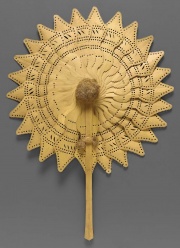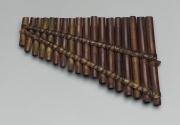Bamboo
Description
The common name for any tall woody grass that grow abundantly in tropical and subtropical areas. Bamboos, with over 480 species, belong to the family Gramineae and the most widely known bamboos come from the Bambusa genera. The woody, jointed stems, called culms, grow to 50 m (164 feet) in height. Bamboo has been used locally for constructing houses, rafts, poles, bridges, and scaffolding. In Europe and America, bamboo stems were popular for chairs, tables, cabinets, and other interior furniture during the 19th century. They are also split, flattened and woven into smaller items such as baskets, mats, hats, and fish traps. Bamboo has also become an important source of long, cellulose fibers for specialty papers. Additionally, a wax is extracted from the bamboo leaves that has properties similar to Candelilla wax.
Synonyms and Related Terms
Bambusa; Bambus (Dan., Deut., Nor., Pol.); bambú (Esp., It.); bambou (Fr.); bamboe (Ned.); bambu (Port.)
Other Properties
Bamboo wax: melting point=78-80, density=0.961, iodine value=7.8, acid value=14.5, saponification value=43.4
| Density | 19-25 ppcf |
|---|
Paper fiber type: Non-woody/grass. Using transmitted light microscopy, fibers appear long, narrow and thick-walled. Pitted vessels (some very wide), barrel-shaped and rectangular parenchyma cells are also present. Unlike other grasses, bamboo does not have serrated epidermal cells. Appearance with Graff's C-Stain: reddish blue. Average dimensions of fibers: length 2.7mm; width 14μm. Common pulping method: Kraft.
Hazards and Safety
Combustible.
Additional Images
Authority
- G.S.Brady, Materials Handbook, McGraw-Hill Book Co., New York, 1971 Comment: p. 83
- Ralph Mayer, A Dictionary of Art Terms and Techniques, Harper and Row Publishers, New York, 1969 (also 1945 printing)
- Matt Roberts, Don Etherington, Bookbinding and the Conservation of Books: a Dictionary of Descriptive Terminology, U.S. Government Printing Office, Washington DC, 1982
- Gordon Hanlon, contributed information, 1998
- E.J.LaBarre, Dictionary and Encyclopedia of Paper and Paper-making, Swets & Zeitlinger, Amsterdam, 1969
- Van Nostrand's Scientific Encyclopedia, Douglas M. Considine (ed.), Van Nostrand Reinhold, New York, 1976
- Random House, Webster's Encyclopedic Unabridged Dictionary of the English Language, Grammercy Book, New York, 1997
- The American Heritage Dictionary or Encarta, via Microsoft Bookshelf 98, Microsoft Corp., 1998
- F. Kidd, Brushmaking Materials, Bristish Brush Manufacturers, London, 1957
- Richard S. Lewis, Hawley's Condensed Chemical Dictionary, Van Nostrand Reinhold, New York, 10th ed., 1993
- Tom Rowland, Noel Riley, A-Z Guide to Cleaning, Conserving and Repairing Antiques, Constable and Co., Ltd., London, 1981
- CRC Handbook of Chemistry and Physics, Robert Weast (ed.), CRC Press, Boca Raton, Florida, v. 61, 1980 Comment: wood: density=19-25 ppcf (0.31-0.40 g/cm3) - wax: melting point=78-80, density=0.961, iodine value=7.8, acid value=14.5, saponification value=43.4
- Marja-Sisko Ilvessalo-Pfäffli. Fiber Atlas: Identification of Papermaking Fibers (Springer Series in Wood Science). Springer, 1995.



